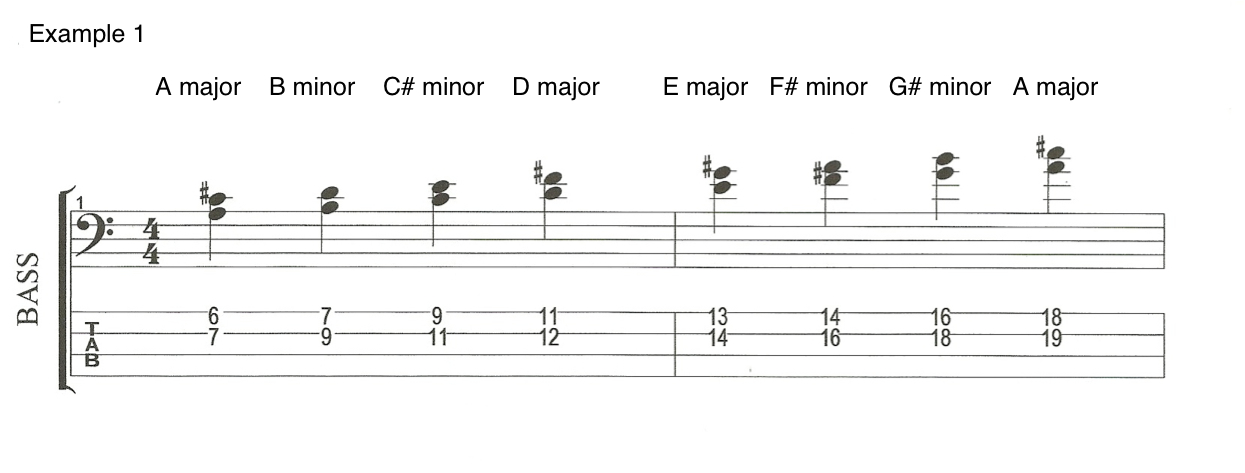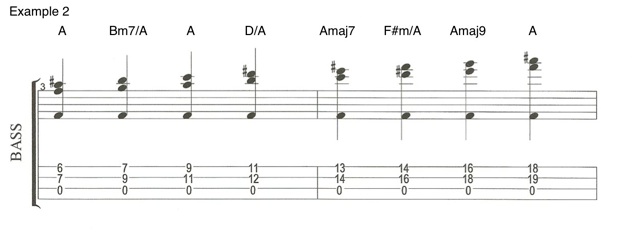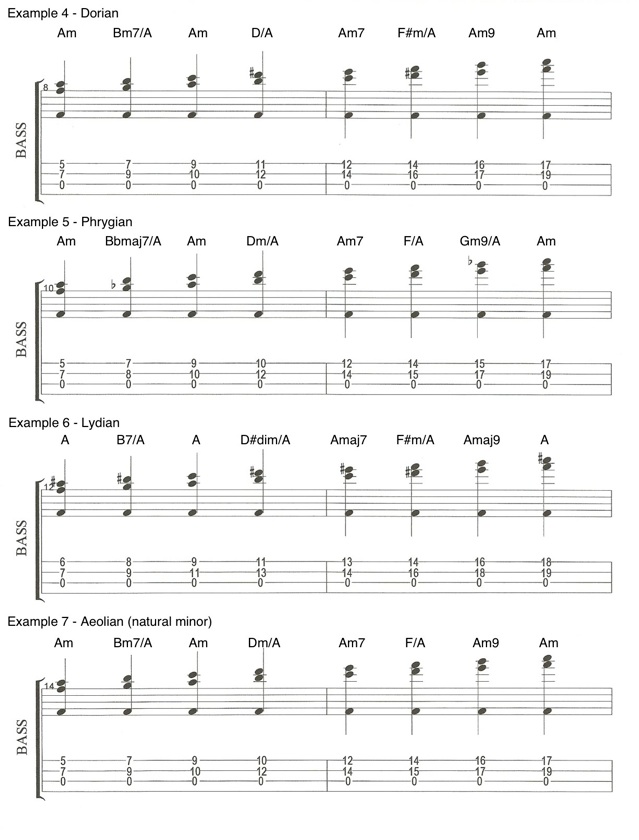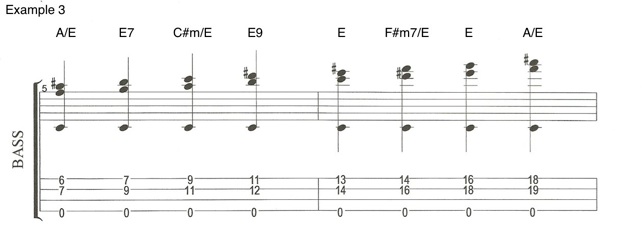Can You Play Chords on Bass Guitar?
I love the sound of chords played on a bass and I use chords a lot in my playing. Apart from just sounding great, practicing chords on the bass has many benefits. The main one is that it really helps you to learn harmony on the fretboard.
Start by Playing Two Notes at a Time
A good place to start is with double stops (playing 2 notes together). In this first example I play an A major scale two notes at a time using intervals of a third. This gives us the foundation of seven different chords.
Click on the examples to make them bigger.
 If you play through my written examples, I would encourage you to not just play them the way they are written, its a ok to start like that but once you feel comfortable with the notes I would recommend changing the order in which you play them as this will help you to experiment and come up with musical ideas of your own. In this second example I play the same notes I played in example 1. However, I also play an open A string with each chord.
If you play through my written examples, I would encourage you to not just play them the way they are written, its a ok to start like that but once you feel comfortable with the notes I would recommend changing the order in which you play them as this will help you to experiment and come up with musical ideas of your own. In this second example I play the same notes I played in example 1. However, I also play an open A string with each chord.
Add Open Strings to Make Chords
 As you can see from the chord symbols written above the notes, adding this open A string changes some of our double stops into chords. I’ll explain below why I have used these chord symbols. If you don’t want to know the chord theory then please feel free to skip onto the next examples.
As you can see from the chord symbols written above the notes, adding this open A string changes some of our double stops into chords. I’ll explain below why I have used these chord symbols. If you don’t want to know the chord theory then please feel free to skip onto the next examples.
Chord Harmony Explained Chords I, II and III
The first chord is still A major but the second chord becomes an inverted B minor 7 chord because the A is the minor 7th relative to the B while the D played on the 7th fret of the G string is the minor 3rd. The third chord is now A major where before it was C sharp minor. This is because the C sharp played on the 11th fret of the D string is the major 3rd relative to our open A string and the E played on the 9th fret of the G string is now functioning as the 5th. These three notes make a simple A major triad (A, C sharp and E) more commonly just written as A.Chord IV
The fourth chord is now an inversion of a D major chord. It’s also a simple triad because there’s a D on the 12th fret of the D string and an F sharp on the 11th fret of the G string. F sharp is the major 3rd relative to D and the open A sting is the 5th relative to D. So these 3 notes make up a D major triad but it’s an inversion because D is not the lowest note. A is the lowest note, so we call the chord D over A.
Chord V
I think of the fifth chord as A major seventh even though it doesn’t contain the major 3rd note, C sharp which is normally found in this chord. It does contain the 5th E and the major 7th G sharp. It’s OK to sometimes leave notes out of chords. On the bass, if we are dealing with extended chords (chords with lots of notes) we will have to leave some notes out so in this case the chord can still function as an A major seventh chord even without the C sharp.Chords VI and VII
The sixth chord is still F sharp minor as it was in example 1. Only now we call it F sharp minor over A because the open A string is now the lowest note. The seventh chord I have called A major ninth because the G sharp played on the 18th fret of the D string is the major 7th relative to A. The B played on the 16th fret of the G string is the 9th. Normally in a full A major ninth chord you would have a C sharp (the 3rd) and an E (the 5th), but the chord can still be thought of as A major ninth. If you are struggling to understand all this explanation of the chord symbols don t worry too much. The most important thing is that you learn what they sound like so you can be creative with them.Change the Open String
In example 3 I still play the same notes as example 1 only now I play an open E string with each chord. This gives you a different sound to example 2 and changes the chords, they’re now mixolydian. This is basically what you get when you play an A major scale over an E note.
Change the Key
Now in the next examples I’ll change things slightly. I’m going to stop using the notes from the A major scale that we worked out in example 1. Instead, in the following examples I’ll use the notes from a G major scale (example 4), F major scale (example 5), E major scale (example 6) and C major scale (example 7), and play each of them with an open A string.
 These examples are meant to demonstrate the different sounds you can achieve on your bass by harmonising different major scales over a single bass note. In this case the single note was our open A string. I’ve added the Greek names for the modes (Dorian, Phrygian, Lydian and Aeolian) to the examples above for your reference.
These examples are meant to demonstrate the different sounds you can achieve on your bass by harmonising different major scales over a single bass note. In this case the single note was our open A string. I’ve added the Greek names for the modes (Dorian, Phrygian, Lydian and Aeolian) to the examples above for your reference.
Learn the Sounds and Come up With Your Own Chords
The examples are certainly not a complete list of all the modes. I’ve simply presented them here so you can take the idea and experiment to come up with your own ideas. The most important thing, as with everything we practise, is to learn the sounds. Once the sounds are in your head and the notes are under your fingers then you’ve achieved the most important target. Learning the names of the chords and the modes is useful, but not nearly as important as learning the sounds they make.
I’ve added one last example here to give you an idea of something slightly different. All my previous examples have used a major scale. In this example I’m using a scale called the melodic minor scale. Try this out and see if you can come up with something interesting.
 * I’ve labeled the 5th and 7th chords here Amaj7 and Amaj9 because that’s what I’ve called the same chords in previous examples. As I mentioned before, neither chord includes a major 3rd but both chords include the note G sharp which is the major 7th relative to A and so they can both function as an A major chord. It is however important to note that the scale I’m harmonising in exercise 8 is an A melodic minor scale. So, if I add the 3rd to either chord then it’s a minor 3rd, not a major 3rd. Then the full chord would be called A minor with a major seventh.
* I’ve labeled the 5th and 7th chords here Amaj7 and Amaj9 because that’s what I’ve called the same chords in previous examples. As I mentioned before, neither chord includes a major 3rd but both chords include the note G sharp which is the major 7th relative to A and so they can both function as an A major chord. It is however important to note that the scale I’m harmonising in exercise 8 is an A melodic minor scale. So, if I add the 3rd to either chord then it’s a minor 3rd, not a major 3rd. Then the full chord would be called A minor with a major seventh.
Now move on to Playing Chords on the Bass – Part 2. You’ll learn how we can make chords by using intervals of 4ths, 5ths and 6ths.



One thought on “Playing Chords on the Bass – Part 1”
Comments are closed.